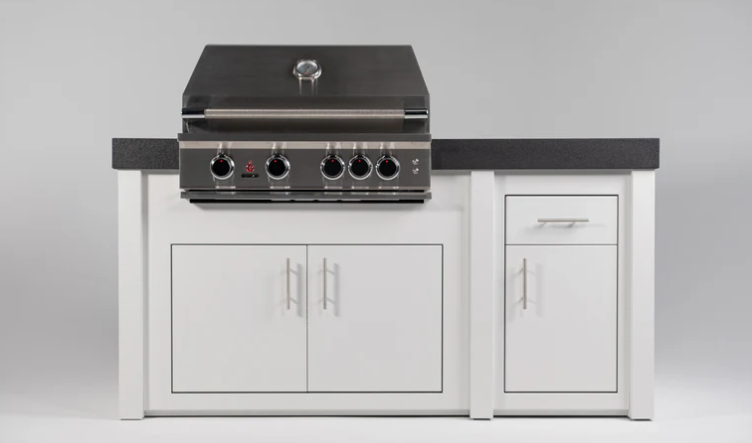(877) 800-6238

Modern Outdoor Kitchen Frame Options
When you start planning your outdoor kitchen design, you’re probably concerned with where it will go and how it will look. While both are important, function is also key, and you will likely spend many hours perusing grills, fridges, and other appliances.
However, you shouldn’t forget that function starts with the base of your kitchen set-up — the framing and construction of your kitchen island. This structure needs to be strong and resilient, not only to support countertops, storage, and built-in appliances but to stand up to hot, cold, and wet weather conditions.
There are several modern outdoor kitchen frame options to explore, including aluminum, wood, concrete, brick, stone, and steel. Which offers the greatest benefits, and which one is right for your home upgrade project?
Resilient Aluminum Framing
It’s hard to argue with the appeal of aluminum. Primarily composed of bauxite and cryolite, aluminum is strong and durable. It’s also lightweight, which makes it easier to transport and position completed designs when you start installing your outdoor kitchen. Aluminum tends to be more cost-effective than some other materials as well.
The main benefit of aluminum is how resilient it is. This material is resistant to rot, rust, and other damage that can impact the usable life of your product. It’s a perfect choice for outdoor applications, where other materials might be subject to harm from weather conditions.
The best products will feature a powder-coated aluminum frame for added protection against the elements and resistance to corrosion. This attractive feature offers practical benefits because it bonds with aluminum to increase resilience while preventing unsightly wear and tear like chipping and peeling.
Aluminum is one of the most common choices for outdoor kitchens, cabinets, furniture, and more.
Sturdy Wood Construction
Wood is often the most cost-effective choice for framing any structure, and it can be quite strong. However, there are several potential drawbacks to this choice, and maintenance is an important consideration.
First, consider how wood holds up to weather. If you have wet conditions, you could end up dealing with issues like mold and rot. Wood shrinks and swells, depending on the temperature, and hot weather could cause it to warp. Wood is also susceptible to a range of pests, from termites to carpenter ants.
Perhaps more important, when it comes to designing an outdoor kitchen, wood is flammable. Putting it near hot surfaces like grills or smokers could be dangerous.
You can account for these hazards in several ways — such as treated lumber, fire-resistant coating, and so on — but this will require upkeep. In other words, wood might not be the best option for framing.
Concrete Blocks, Bricks, or Stacked Stone
There are several benefits to choosing materials like concrete blocks, bricks, or stacked stone when constructing your outdoor kitchen. These items are famously durable and weather-resistant. They’re also available at a range of prices, with concrete blocks on the lower end and stacked stone entailing greater expense.
Concrete offers a modern appearance, while brick is more traditional, and stacked stone features the appeal of natural elements.
However, building structures this way is time-consuming, which can add labor expenses, and you’ll probably need a professional to install such materials. If a portion of your structure is damaged, it will also require a lot of labor to fix.
Steel
Common in food-safe countertops and appliances, steel can also be used to construct kitchen islands. Steel is incredibly strong and durable, making it a great choice for lasting structural support. However, there are some potential drawbacks to choosing this material.
For one thing, steel is one of the more expensive options you can choose. Also, because this alloy is primarily a mixture of iron and carbon, it will rust if exposed to moisture. You’ll notice that counter surfaces and appliances are usually stainless steel, featuring chromium content that adds resistance to rust and corrosion.
For framing, you’re more likely to find galvanized steel, where the metal is coated with a zinc-iron alloy. However, if the coating is damaged, it will lose protective properties. Generally, aluminum is a better choice thanks to its lightweight, resilient properties and better pricing.
Discuss Your Options With an Experienced Design Consultant
Designing an outdoor kitchen is a complex undertaking. There’s no shortage of decisions to make when it comes to the function and aesthetics of this outdoor entertaining space.
If you need guidance throughout the design process, including information about framing materials best suited to kitchen island construction, an experienced design consultant can help. This professional has the knowledge, skill, and creativity to bring your unique vision to life and ensure the beautiful, functional space you deserve.
Whether you opt for aluminum, lumber, stone, or steel, it’s important to understand the pros and cons of any frame selection before making the choice that’s right for you.
Build Your Custom Modern Outdoor Kitchen

Let the experts at Stono Outdoor Living help create your dream outdoor kitchen. Start building your kitchen with our 3D configurator; it's simple and easy to use. Or schedule a no-obligation design consultation to tailor a custom outdoor kitchen design that combines comfort, functionality, and style. We guarantee a perfect fit, free shipping, and easy assembly. Shop Islands or Schedule a Consultation today.
